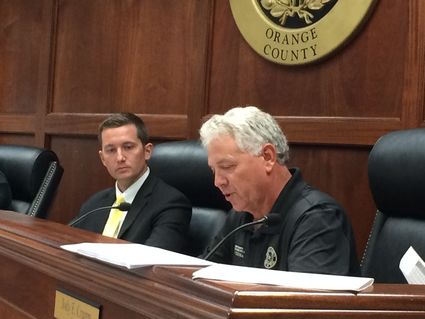OC employees get 5 percent pay increase
Last updated 8/1/2017 at Noon
For The Record
Orange County Commissioners stopped for a rare applause break Tuesday afternoon after they unanimously voted to give the county’s 250 non-elected, non-union employees a 5 percent pay hike.
The motion also included adjustments to the employee pay matrix designed to award higher starting salaries and also reward long-time employees.
“I’m sure most people have heard by now we are doing much better financially this year than in any point in the last four years,” County Judge Stephen Brint Carlton said.
He was referring to a weekend report on the Record Newspapers’ website, therecordlive.com.
In it, Carlton said that County Auditor Pennee Schmitt, working with Carlton and Commissioner John Gothia, had determined the county’s reserve fund balance had topped the $12 million mark – the recommended 25 percent of the annual budget to be set aside for emergencies – by several million dollars.
“We have reached our 25 percent fund balance goal, so this is our chance to start doing more for our employees,”
Carlton said.
The 5 percent raise will cost $850,000 for non-union employees.
The county, in ongoing negotiations for a new work contract with the Orange County Sheriff’s Office Employees Association, offered to match any non-union employee raise for the 140 union employees, another $294,000 expense.
Commissioner Jody Crump initially said he’d be more comfortable granting just a 3-percent pay raise. Commissioner Barry Burton mentioned that being a coastal county, Orange should try to put more than $12 million emergency funds aside.
After listening to more discussion, Crump cast the first vote in favor of the 5-percent raise, noting “I know that’s a shock,” and Burton followed suit.
Carlton and Gothia said they felt confident the county could afford the $1.15 million increase and still have money left over to up its commitment to boost economic development efforts.
“We’ve been working on this a while. Each month continued to get a little better and a little better to where we’re in a pretty strong financial position,” Gothia said.
The old employee pay matrix included a pay bump after one year and others at years 5, 10 and 15. The new matrix would do away with the first-year bump, allowing new hires to get higher pay, and add a 20-year raise.
“We wanted to be competitive within the market place [for new hires], and also be able to benefit the people who have been here and been loyal,” Gothia said.
“We’re not having to touch our tax base to do it. We’ve saved our money over the years and adjusted to where we’re comfortable to be able to do this, and not have to ask our citizens for anything else to do this.
“That was a big key, too. We wanted to take care of our people who work here, and we also wanted to take care of our citizens. I think we’ve done both of those.”
Carlton mentioned a possible cut in the county tax rate in his interview with the Record Newspapers, and Tuesday said that was on the agenda to talk about later in the budgeting process.
The 2018 budget must be approved by October 1, when the new fiscal year begins. Among things likely to be on it is the first raise since 2009 for elected officials.
Law requires commissioners to post for comment any possible raises for elected officials so that projection is the first step of the official budget process.
The projected raises for 18 elected officials totaled another $175,000, but the court made it clear at the July 25 meeting that it would not vote for those pay raises unless it determined there was enough for employee raises.
Carlton, Crump and Burton, all of whom are up for re-election in 2018, have filed paperwork to defer any possible pay raise until their next terms.
In other action Tuesday, the commissioners paid $753,000 in bills, including a $404,000 check for August health insurance for employees and retirees under 65.
In the comment section at the end of the meeting, Carlton noted that the Texas Transportation Committee had approved the FM 299 project, also known as the Vidor Loop.
“That does not mean Orange County has approved the Loop 299 project,” the judge said.
“I’m neutral to the project. I think a lot of us are still trying to understand what it is; what the costs are. Until we do get that information, we can’t make a decision.”
Carlton said when the information is received, he plans to hold two public meetings to get feedback from the community.
“It really does have a very big difference on cost benefit analysis depending on the money TxDOT is willing to contribute and what that timeline is to contribute it.”









Reader Comments(0)